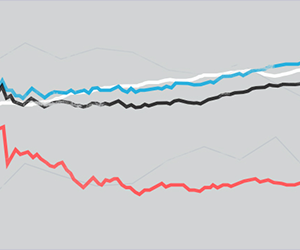 What does it mean to be a data-driven lawyer in 2018? For most law firms, it means access to key data points that can help inform better, more confident business decisions.
What does it mean to be a data-driven lawyer in 2018? For most law firms, it means access to key data points that can help inform better, more confident business decisions.
The problem for most firms is getting quality data. Fortunately, as firms rely more on technology, we’re able to generate reliable insights that are both context-specific and actionable.
This is something we’ve taken on with our annual Legal Trends Report, which looks at aggregated and anonymized data from the Clio platform. In the report, we look at average hourly rates across states and practice areas, and we conduct an in-depth analysis of just how much time lawyers are able to spend on billable work each day.
We also look at average case values based on practice area. To do this, we aggregated case values for those closed in 2017, segmenting them by practice area, and then calculating both a mean average and overall distribution of amounts collected.
These are the average mean (and median) values we discovered for common practice areas (see the full list in the report):
- Criminal: $1,482 ($750)
- Family: $3,165 ($1,538)
- Immigration: $1,492 ($950)
- Personal injury: $3,334 ($1,500)
- Real estate: $1,537 ($595)
- Traffic offenses: $708 ($300)
- Wills & estates: $1,461 ($750)
One data point that stands out is that the median is lower than the average for each practice area. This suggests most firms rely on a small number of higher value cases for a large portion of their revenues; meanwhile, a large bulk of cases are of lower value.
What’s also important to consider is how law firms can actually use this information. Here are four ways to make this information actionable at your firm.
1. Compare the value of your cases to industry data
This may seem obvious, but the first thing law firms should do is compare their average case values to these industry benchmarks (start with our benchmark calculator). If they don’t line up, the next step is to begin exploring why. It may have to do with regional factors, which we also look at in the Legal Trends Report, but it could also be the fact that your firm is charging too much or too little.
2. Evaluate your budget for acquiring new cases
If you can estimate how much each new case is worth to your firm, you can then make decisions on how much you want to invest in acquiring those cases. Your acquisition spend might include marketing, intake, and all of the time spent seeking new clients. And if the amount you spend to get a case is more than what it brings in, you’ll need to look at how to make your client acquisition cheaper or more effective.
3. Benchmark your alternative fee structures
Alternative fee structures such as flat fees, capped fees, or performance-based fees can be a way to offer more transparency and reduce “sticker shock” for clients. But if you’re just starting out, setting these rates might require a bit of guesswork. Benchmarking your pricing structures against industry data will give you more confidence in knowing what the market will bear.
4. Determine how many cases you need to be profitable
If you know how much it costs to run your firm, including how much you and everyone at your firm expects to take home at the end of the day, you can calculate how many cases your firm needs to take on. From there, you can review your targets on an annual or monthly basis and adjust your business strategy accordingly.
Average case values are just a small portion of industry insights we’ve been able to look at in this year’s Legal Trends Report. Read the full report for more industry data and analysis.
 George Psiharis is the Vice President of Business Operations at Clio. Specializing in customer development and data operations, George has worked extensively with law schools, bar associations, and other legal professionals to help make information on cloud computing and law firm economics increasingly accessible.
George Psiharis is the Vice President of Business Operations at Clio. Specializing in customer development and data operations, George has worked extensively with law schools, bar associations, and other legal professionals to help make information on cloud computing and law firm economics increasingly accessible.